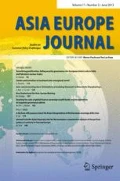Abstract
The Asia-Europe Meeting (ASEM) held its 9th Summit in November 2012, marking 16 years of existence. Because of its biennial character, around the time of Summits, ASEM usually gains increased attention. And it is around each Summit that questions about ASEM’s relevance and contribution to global politics re-surface. While political and economic cooperation have attracted much anticipation and analyses, this essay draws attention to the under-researched socio-cultural pillar. It re-assesses the role of socio-cultural cooperation in the relations between Asia-Europe and its relevance to the Asia-Europe Meeting process overall. The study analyses the stream of activities and the design of programmes coordinated by the Asia-Europe Foundation (ASEF), the only permanent institution of the ASEM process, responsible for the “third-pillar” implementations. ASEF in this analysis serves as a reflection of ASEM, and by looking into working mechanisms and evaluating ASEF’s effectiveness, the author evaluates ASEM. The purpose of this study is to offer the first comprehensive analysis of Asia-Europe Foundation, which recently celebrated its 15th anniversary, by examining its relationship with the ASEM process. The study evaluates ASEF’s contribution to Asia-Europe inter-regional cooperation and outlines the limitations that the Foundation faces. A multi-method research approach is adopted including data from the ASEF archives and reports of its activities, and analysis based on the existing literature and official documents of ASEM and ASEF, as well as in-depth interviews conducted by the author.


Similar content being viewed by others
Notes
Interviewee 3, June 2012.
Interviewee 13, June 2012.
Details of each of these projects can be found on the ASEF website: http://www.asef.org/index.php/projects/programmes, accessed on 28 March 2013.
The Mutual Perception of Asia and Europe Studies project was launched in partnership with European Studies in Asia, Konrad Adenauer Stiftung, National Center for Research on Europe, Canterbury University and Fudan University. Two significant publications have, thus, far been completed, “The EU through the eyes of Asia” and “Asia in the Eyes of Europe”. http://asef.org/index.php/projects/themes/education/1148-asia-in-the-eyes-of-europe, accessed on 30 November 2012].
The above information was confirmed with Interviewee 3, June 2012.
Details of the program: http://asef.org/index.php/projects/themes/environment/2647-asia-europe-environment-forum-in-rio-plus-20, accessed on 30 November 2012.
Interviewee 4, June 2012.
Data provided by ASEF statistics: http://www.asef.org/index.php/about/what-we-do and http://asef.org/index.php/about/partners, accessed on 28 March 2013.
List of themes and topics of ASEF’s work is available on the official website: http://asef.org/index.php/projects, accessed on 30 November 2012.
Interviewee 3, April 2010. The “blame game” refers to the European tendency of criticizing some Asian countries’ human rights records.
Further details: http://www.asef.org/index.php/projects/themes/human-rights/2766-asem-outlook-2012#2823-asem-outlook-report-published, accessed on 6 December 2012.
Interviewee 10, June 2012.
Interviewee 14, June 2012.
Interviewee 2, June 2012.
Interviewee 2, June 2012. The interviewee refers to the Asian financial crisis in 1997 that’ happened soon after the establishment of ASEF and the current financial crisis in Europe.
Interviewee 11, June 2012.
Interviewee 11, June 2012.
Information obtained from internal documentation of ASEF, June 2012.
Only five people stayed longer than 5 years within the organization. Information obtained from ASEF internal documentation, June 2012
Interviewee 15, June 2012. “Obama factor” is a comparison of a strong and attracting public attention personality, in this case the U.S. President Barrack Obama. ASEM, unlike APEC, does not have a leader that would be able to raise the media profile of the Summits.
Interviewee 6 and 14, June 2012.
Interviewee 6, June 2012.
The official website of ASEM (www.aseminfoboard.org) is managed by ASEF’s Public Affairs Department.
Quotes collected through series of interviews with ASEF staff.
Interviewee 19, June 2012
References
ASEF (2009) Dialogue of cultures and civilisations: programme evaluation. Executive summary. ASEF, Singapore
ASEF (2011) Financial Report. http://www.asef.org/ebooks/annualreport/2011/Financial-Information/. Accessed 30 November 2012
ASEM (1996) Chairman’s statement of the Asia-Europe Meeting. ASEM, Bangkok
ASEM (2000) Chairman’s statement of the third Asia-Europe Meeting. ASEM, Seoul
ASEM (2002) Chairman’s statement of the fourth Asia-Europe Meeting. ASEM, Copenhagen
ASEM (2004) Chairman’s statement of the fifth Asia-Europe Meeting. ASEM, Hanoi
ASEM (2005) Bali Declaration on Building Interfaith Harmony within the International Community. http://www.asef.org/images/docs/868-Bali_Declaration.pdf. Accessed 30 November 2012
ASEM (2006) Chairman’s statement of the sixth Asia-Europe Meeting. ASEM, Helsinki
ASEM (2008) Chairman’s statement of the seventh Asia-Europe Meeting. ASEM, Beijing
ASEM (2010) Chairman’s statement of the eighth Asia-Europe Meeting. ASEM, Brussels
ASEM (2012a) Chairman’s statement of the nineth Asia-Europe Meeting. ASEM, Vientiane
ASEM (2012b) Asia-Europe Meeting Achievements. http://www.aseminfoboard.org/component/k2/item/10.html?Itemid=245nu-achievements.html. Accessed 30 November 2012
Bersick S (2008) The democratization of inter- and transregional dialogues: the role of civil society, NGOs and parliaments. In: Ruland J, Schubert G, Schucher G, Storz C (eds) Asian-Europe relations. Building blocks for global governance? Routledge, New York, pp 244–270
Gaens B (2008) ASEM as a tool to “bridge the cultural divide”. In: Gaens B (ed) Europe-Asia interregional relations: a decade of ASEM. Ashgate, Aldershot, Hampshire, pp 85–100
Japan Center for International Exchange and University of Helsinki Network for European Studies (2006) ASEM in its tenth year: looking back, looking forwards. An evaluation of ASEM in its first decade and an exploration of its future possibilities. Japan Center for International Exchange, Tokyo
Keva S (2008) ASEM and civil society. In: Gaens B (ed) Europe-Asia interregional relations: a decade of ASEM. Ashgate, Hampshire, pp 101–114
Kim SH (2010) ASEM 7 and developments of its socio-cultural dimension. http://kimbriss.cafe24.com/upload/01Si_Hong_Kim.pdf. Accessed 2 October 2013
Lai SY, Chaban N (2009) ASEM under the radar: media portrayals of Asia-Europe Meeting in Asia. In: Holland M, Chaban N, Ryan R (eds) The EU through the eyes of Asia (volume 2) new cases new findings. World Scientific Publishing, Singapore, pp 217–245
Pereira R (2007) The Helsinki summit and the future course of Asia-Europe Meeting. Asia Europe Journal 5(1):17–21
Yeo LH (2004) Asia and Europe: the development and different dimensions of ASEM. Routledge Advances in International Relations and Global Politics, Routledge
Author information
Authors and Affiliations
Corresponding author
Rights and permissions
About this article
Cite this article
Le Thu, H. Evaluating the cultural cooperation: the role of the Asia-Europe Foundation (ASEF) in the Asia-Europe Meeting (ASEM) process. Asia Eur J 12, 401–418 (2014). https://doi.org/10.1007/s10308-014-0390-x
Published:
Issue Date:
DOI: https://doi.org/10.1007/s10308-014-0390-x



